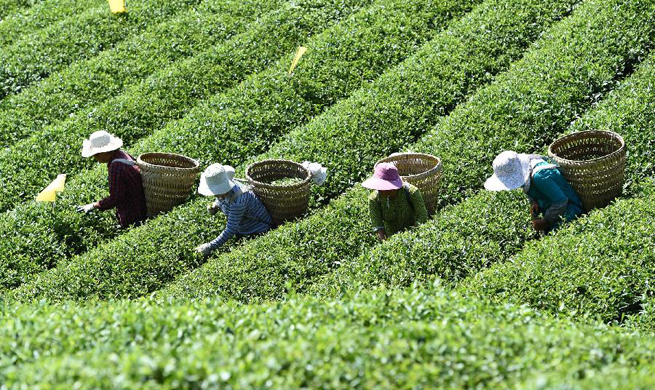HARARE, Aug. 7 (Xinhua) -- The Cotton-to-Clothing (C2C) Export Strategy launched by Zimbabwe in 2014 to boost domestic production and promote export of textiles and garments is still on course despite the devastating drought that hit the country in 2015/16, an official said Monday.
The strategy, which aims to increase cotton production three-fold by 2019, revive the cotton and textile industry and help boost the country's economic growth, was developed by the Ministry of Industry and Commerce with support from the International Center for Trade (ICT), a joint agency of the United Nations and the World Trade Organization.
It was funded by the European Union (EU) under the EU-Africa Partnership on Cotton, and the African, Caribbean and Pacific Group of States (ACP) with international and regional development partners expressing interest in financing and supporting activities elaborated in the strategy's plans of action.
ICT spokesperson Jarle Hetland told Xinhua Monday that while they were still hoping to see a three-fold increase in cotton production by 2019, the project had unfortunately not been progressing as fast as they had hoped.
"There are several reasons for this, including drought, which has severely affected cotton growers, but also the related limited investment in productivity.
"However, the implementation of the project carried out by ITC and COMESA is on track and is helping ensure that the sector is ready to grow and scale up its activities," he added.
Seed cotton production decreased by 23 percent to around 80,000 tons in 2015/16 following the severe drought that hits the whole of Southern Africa.
More than 100 stakeholders from the Cotton-to-Clothing sector, including representatives of the public sector, rural communities, small and medium-sized enterprises and civil society, were involved in defining a series of market-led development priorities to support the strategy.
The C2C strategy was launched as a part of the EU-funded regional "Coordination of African Regional Cotton Sector Strategy" led by the Common Market for Eastern and Southern Africa.
ITC was later invited by COMESA to assist Zimbabwe in the implementation of some aspects of the strategy, in particular training activities, market intelligence tools and market linkages, institutional capacity building to support private sector and carry out an industry wide audit for future business development in the COMESA Free Trade Area.
"The implementation of the strategy is still on course. The government working with the private sector is making all efforts to ensure that the activities identified are implemented," Hetland said.
He said part of the effort was being led by a local textile group and the Association for Cotton Value Adders of Zimbabwe.
"They are receiving support from the ministry on continued implementation of the strategy. In addition, what would be of benefit to the Zimbabwean cotton industry is agreement on the proposed strategic partnership with Cotton South Africa and other regional partners," he said.
The strategy has identified key markets in Africa, Asia and Europe where the value, diversity and attractiveness of 'Made in Zimbabwe' products has not yet been tapped.
It is hoped that the strategy will deliver a unifying roadmap with an ambitious set of targets, including a steep increase in yields to 1,200 kilograms per hectare that will benefit 250,000 smallholder farmers and increase production of cotton lint to 450,000 tons per year.
Zimbabwe produced about 150,000 tons in 2013 at an average 269 kg per hectare.
A substantial increase in cotton production to around 210,000 tons in the 2016/17 marketing year has been forecast on the back of the government's inputs support program to revive cotton production and the support given by ginners and merchants through contract farming schemes with smallholder farmers.
Export of textiles and garments is expected to reach 7.5 million U.S. dollars and set out a roadmap to help the country regain its leadership in quality and value addition in the C2C sector by 2019, when the implementation of the strategy is expected to be complete.
The sector extends from smallholder farming which contributes to the livelihoods of more than 1 million Zimbabweans to capital-intensive sub-sectors such as spinning and textiles that have played an integral role in the country's industrialization.
It also has important food-security implications with cottonseed processing by-products used as animal feed, while cottonseed oil is used for human consumption.
Zimbabwe's clothing and textile industry was once one of the country's biggest employers with about 24,000 workers, but problems such as inadequate capital, power shortages, high labor costs and obsolete machinery have led many companies to operate at below 10 percent of their capacity.
The labor force has also declined to less than 4,000 because of company closures which affected ginners, spinners, knitters and weavers, dye houses, clothing companies and retailers as some were either placed under judicial management or liquidated.
As a result, Zimbabwe is currently exporting most of its cotton lint without adding any value to it, while cheap imports from Asia are flooding the market. The local clothing industry is also only able to meet about 25 percent of local demand.

















